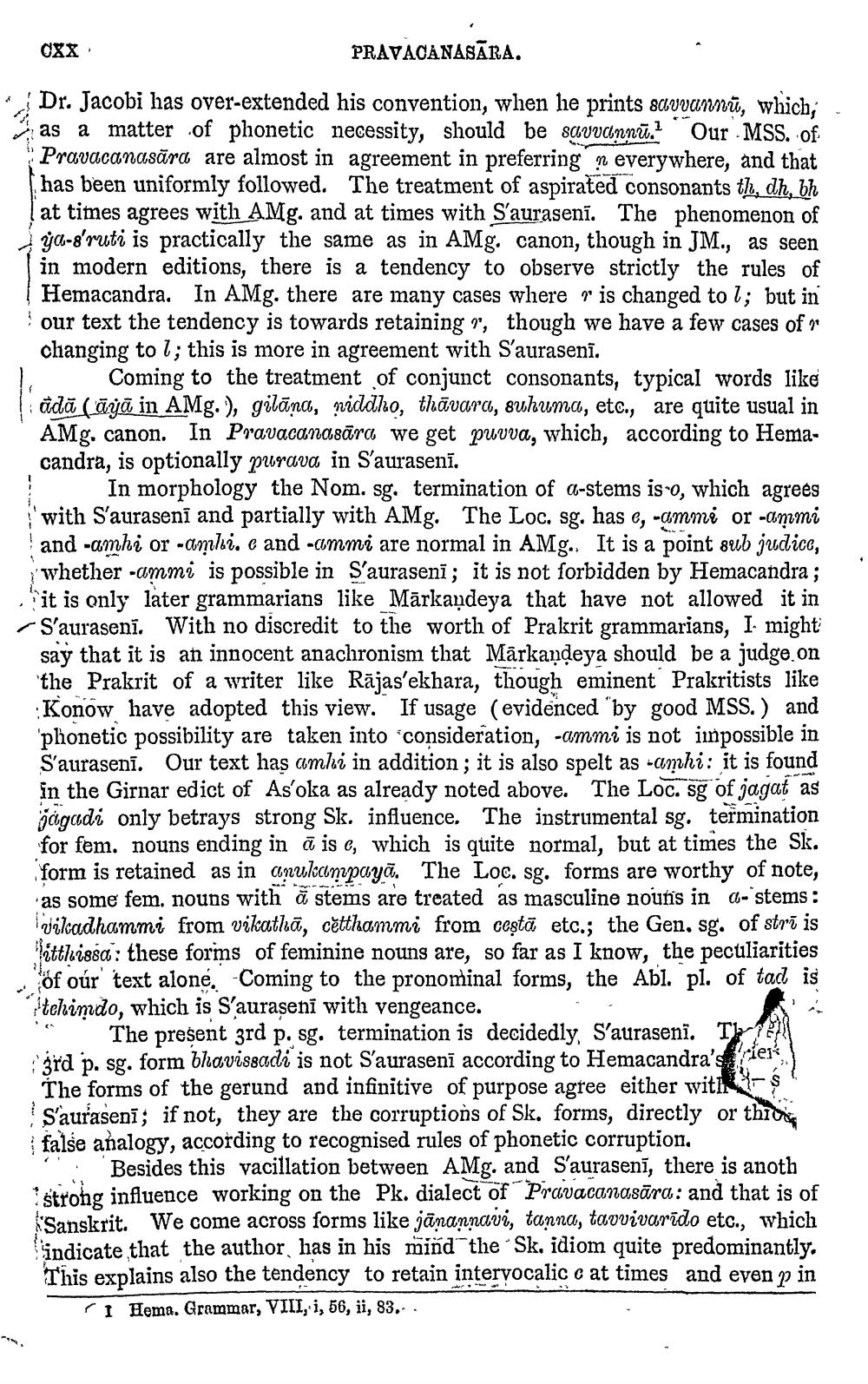________________
OXX
PRAVACANASĀRA.
Dr. Jacobi has over-extended his convention, when he prints savvannū, which, as a matter of phonetic necessity, should be savvannū. Our MSS. of Pravacanasāra are almost in agreement in preferring everywhere, and that has been uniformly followed. The treatment of aspirated consonants th, dh, bh lat times agrees with AMg. and at times with Saurasenī. The phenomenon of
ya-s'ruti is practically the same as in AMg. canon, though in JM., as seen in modern editions, there is a tendency to observe strictly the rules of Hemacandra. In AMg. there are many cases where go is changed to l; but in our text the tendency is towards retaining 1, though we have a few cases of changing to l; this is more in agreement with S'aurasení.
Coming to the treatment of conjunct consonants, typical words like adā (ājā in AMg. :), gilāna, riddho, thāvard, suhuma, etc., are quite usual in AMg. canon. In Pravacanasāra we get puvva, which, according to Hemacandra, is optionally purava in Saurasenī.
In morphology the Nom. sg. termination of a-stems is-o, which agrees 'with Saurasens and partially with AMg. The Loc. sg. has e, -ammi or -animi and -amhi or -anlio e and -commi are normal in AMg. It is a point sub judico, whether -ammi is possible in S'aurasenī; it is not forbidden by Hemacandra; it is only later grammarians like Mārkaņdeya that have not allowed it in S'aurasení. With no discredit to the worth of Prakrit grammarians, I. might say that it is an innocent anachronism that Märkandeya should be a judge on the Prakrit of a writer like Rājas'ekhara, though eminent Prakritists like Konow have adopted this view. If usage (evidenced "by good MSS.) and 'phonetic possibility are taken into consideration, -ammi is not impossible in S'aurasenī. Our text has amhi in addition, it is also spelt as -amhi: it is found in the Girnar edict of As'oka as already noted above. The Loc. sg of jagat as jagadi only betrays strong Sk. influence. The instrumental sg. termination for fem. nouns ending in ā is e, which is quite normal, but at times the Sk. form is retained as in anukanpayā. The Loc. sg. forms are worthy of note, as some fem. nouns with ā stems are treated as masculine nouřis in a-stems: Viladhammi from vikatlā, cetthammi from cestā etc.; the Gen. sg. of strī is itthissa: these forms of feminine nouns are, so far as I know, the peculiarities of our text alone. -Coming to the pronominal forms, the Abl. pl. of tad is Atelindo, which is S'auraşeni with vengeance.
The present 3rd p. sg. termination is decidedly. S'auraseni. The žrd p. sg. form bhavissadi is not Saurasenī according to Hemacandra's frien Íhe forms of the gerund and infinitive of purpose agree either wit h S'auřasenī; if not, they are the corruptions of Sk. forms, directly or thicco false analogy, according to recognised rules of phonetic corruption. " Besides this vacillation between AMg. and S'aurasenī, there is anoth strong influence working on the Pk. dialect of Pravacanasāra: and that is of K'Sanskrit. We come across forms like jānannavi, tanna, tavvivarīdo etc., which Sindicate that the author has in his mind the Sk. idiom quite predominantly. This explains also the tendency to retain intervocalic c at times and even p in
I Hema. Grammar, VIII, i, 56, ii, 83...




